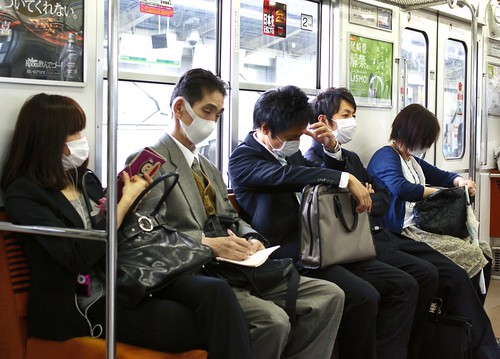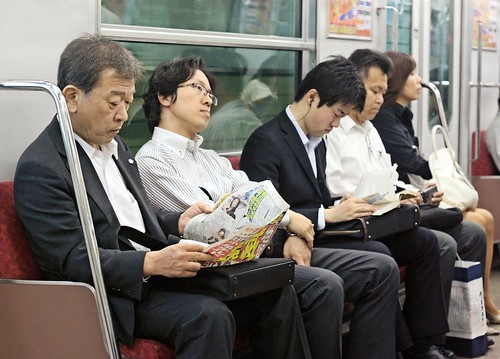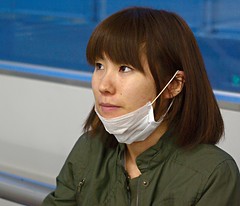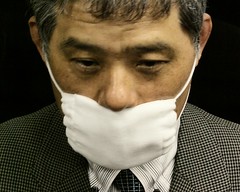People here are nothing if not trend-conscious. The top picture was typical for my commute two weeks ago: most people (though far from all) wearing masks. Fast forward two weeks and to the bottom picture. Mask use is now almost back to the levels you'd have before the swine flu outbreak started. And this is despite the fact that the number of cases are still increasing - over 400 are infected in Japan now - and most infections are still in the Kobe-Osaka area.
Why would that be? I can think of a few reasons. The most optimistic possibility is that people are interested and well informed and, given time, able to make good judgments based on the flow of conflicting news and opinion.
One major difference between mid-May and today is that the rate of infection and severity in Japan is becoming clearer. People are able to consider the risk and they're concluding that the danger to themselves is not great. Also, there's been several high-profile reports showing that a mask really isn't helpful. In one good televised experiment, only three of eight volunteers were actually protected by wearing an N95 (antiviral) mask, fitted by a medical professional. The other five had small facial features, uneven skin or other issues that prevented the mask from working properly. When they tested normal surgical masks on the volunteers, none of them got any protection whatsoever.
One major difference between mid-May and today is that the rate of infection and severity in Japan is becoming clearer. People are able to consider the risk and they're concluding that the danger to themselves is not great. Also, there's been several high-profile reports showing that a mask really isn't helpful. In one good televised experiment, only three of eight volunteers were actually protected by wearing an N95 (antiviral) mask, fitted by a medical professional. The other five had small facial features, uneven skin or other issues that prevented the mask from working properly. When they tested normal surgical masks on the volunteers, none of them got any protection whatsoever.
One reason people aren't wearing masks anymore could be that this message has been widely accepted: the risk of infection is low so there is little reason to panic, and a mask isn't really protecting you to any significant degree.
A second, less optimistic possible reason might be that people in general just follow the crowd and have the collective attention span of an over-caffeinated hamster. When swine flu was the disaster news of the day, anxious people reflexively put on masks and risk-averse managers ordered masks for their employees. Other people followed them because, well, you do what your friends and coworkers do. By now the media has moved on and dropped the disaster headlines. And with no fear-mongering to stir people up they've soon tired of it and dropped the masks along with any interest in the story. It would explain all those people wearing masks in ways that could not possibly protect them in any way; they're a symbol of belonging and a token of support, nothing else.
People may have dropped the mask not because of any rational decision in other words, but because worrying about swine flu is just so last week. Masks are no longer trendy.
People may have dropped the mask not because of any rational decision in other words, but because worrying about swine flu is just so last week. Masks are no longer trendy.
The real answer is of course more complicated. Some people follow the news and other information and make a deliberate decision. Other people follow the group consensus. That's not a bad strategy, by the way: when "everyone" starts doing something there's probably a good reason for it. It's probably initiated by people that know the issue well, whether fashion trendsetters or mask wearing. You delegate decisions you don't know enough about to the group, leaving you free to focus on your particular interests. "Follow the group" may sound spineless and passive, but call it crowdsourcing and it'll be hip and farsighted.
Whatever the dynamic, masks have largely disappeared again, as quickly as they first appeared. Vaccines are being developed, and as there's a real risk that swine flu follows earlier pandemics and comes back with a vengeance within the next couple of years. If the same group dynamic that made everyone don paper tissues can be used to get everyone vaccinated it can potentially save quite a few lives down the line.





No comments:
Post a Comment
Comment away. Be nice. I no longer allow anonymous posts to reduce the spam.